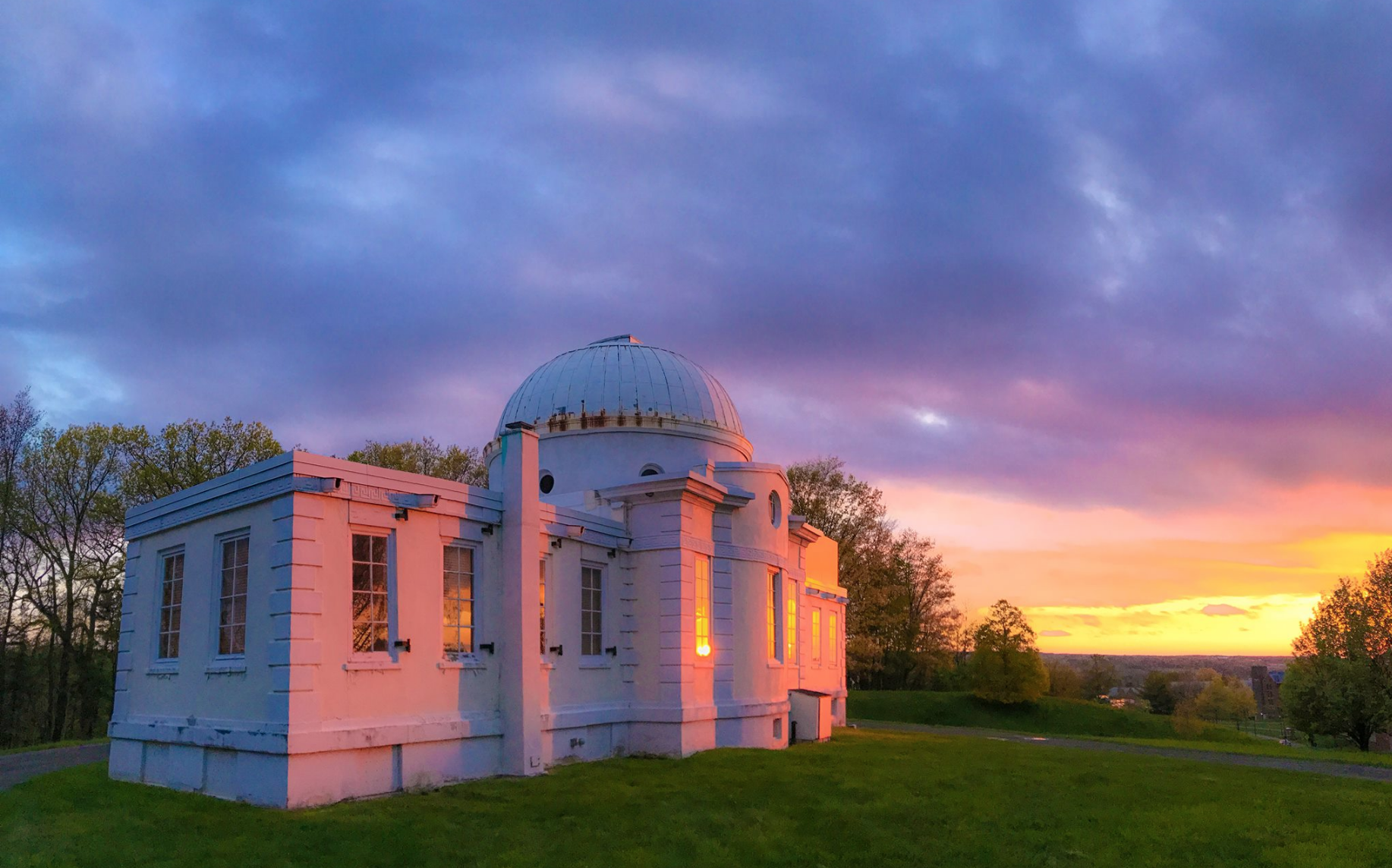
Giving a public talk
I am so happy, but not as happy as the Earth.
Undergraduate Outreach Table of Contents
The Cornell Astronomical Society (CAS) is the undergraduate student-run organization that runs the on-campus Fuertes Observatory. While some of us study physics or astronomy, the majority of our club members represent a wide variety of majors, both inside and outside of other science fields. We are rounded out by members of the Cornell Astronomy Department and local amateur astronomers.
Our primary activity as a club is to host weekly public stargazing nights at the observatory. We also hold a public lecture series as an "opening act" to our observing nights, featuring talks from both our own members and faculty from the Astronomy Department. The centerpiece of our stargazing nights is the 12-inch Irving Porter Church refractor telescope (known as Irv), which is over 100 years old and still manually-operated! We also have a 10-inch Dobsonian telescope, among others, that we use on the observing deck.
I joined the Cornell Astronomical Society for several reasons. First, I was always going to join the astronomy club regardless of who they were or what their purpose was. Originally, I just assumed it was a club for astronomy majors. Second, I was enthralled by the possibility of running an observatory because I had never even used a telescope to go stargazing before I joined the club. I never could have imagined that undergrads were the ones who ran the observatory either.
Running the observing nights offered an excellent opportunity to talk to the public about astronomy. It also gave me a lot of practice using the refractor telescope. (You haven't felt pressure until you have been faced with trying to find Andromeda with dozens of people who have never been to an observatory before waiting for a half hour, only to have to tell them it's too cloudy to see anything.) Additionally, it also gave me an established venue for staging my own public talks on astronomy, which was a great fit for me since I love giving presentations.
I was a member of the club all four years, serving as president in my junior year and vice president the year before that. During this time, I organized the lecture series and also gave three public talks as part of the series that you can find below. I also started a tradition of annually celebrating Yuri's Night, which my fellow club leaders quickly grew into our largest event and is currently in its sixth year as of 2019.

I am so happy, but not as happy as the Earth.


Open every Friday night. We do tours on cloudy nights!


I definitely did not bake any of this food.

Actually, yes! You can find that poster below!
The Cornell Society of Physics Students is the undergraduate club for physics majors, and a chapter of the national SPS organization. We hold monthly physics and pizza lecture series featuring physics talks mostly given by members of the department. We organize lunches with important colloquium speakers. We hold social events. And most importantly, we do outreach!
I became the outreach coordinator of Cornell's SPS chapter because I wanted to participate in outreach events myself, and I also wanted to get other students involved in outreach.
My favorite outreach event at Cornell was Expanding Your Horizons, a one-day conference that brings middle school girls from across New York State to Cornell to take part in a wide variety of hands-on science workshops. Each year, SPS members would run a demo booth that EYH attendees could check out during breaks in-between workshops. In my junior year, I developed a simple take-home workshop in which we gave out CDs that attendees could use to make their own spectrometers (see below). In my senior year, my successor to the outreach coordinator position, Omar Alam, led a workshop in which attendees made their own radios! Here is the worksheet for that workshop.
We also regularly participated in NanoDays, an annual event held either on campus or at the Ithaca Sciencenter that focused on getting elementary and middle school students interested in nanotechnology and its mainstream applications.
The Triple Helix is an international undergraduate student-run journal that explores the impact of science in society. We were founded at Cornell in 2004 and has expanded to include over 20 chapters at universities around the world. Each chapter publishes an issue every semester (twice a year) composed of all of the articles from that chapter's writers in addition to a variety of International Feature articles from other chapters and a common cover article.
The name The Triple Helix refers to the interconnection between the journal's three areas of focus: science, society, and law.
In general, I love writing. As an astronomer, I don't often get the chance to conduct, read, or write about research that has a direct impact on society. The Triple Helix gave me a rare opportunity to write about the impact of astronomy on society!
I wrote one article for the Spring 2012 issue titled The World Without the Space Shuttle about the state of human spaceflight in the United States shortly after the shutdown of the Space Shuttle program. The article was selected as an International Feature to be published at several other chapters outside of Cornell. You can find the article here.
ZME Science is a popular science website that produces daily concise articles on the latest science news and developments.
I read ZME Science as an undergraduate to stay up-to-date on advances in science in general. Like with The Triple Helix, I saw the website as an another opportunity to write for a publication that focuses on science in society. I also viewed writing for the site as good practice for applying to write for Astrobites the following year once I entered graduate school.
I wrote three astronomy-themed articles for ZME Science:
Find me in my office, or send me an email!